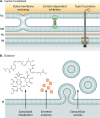Multifaceted Interfaces of Bacterial Competition
- PMID: 27246570
- PMCID: PMC4966439
- DOI: 10.1128/JB.00275-16
Multifaceted Interfaces of Bacterial Competition
Abstract
Microbial communities span many orders of magnitude, ranging in scale from hundreds of cells on a single particle of soil to billions of cells within the lumen of the gastrointestinal tract. Bacterial cells in all habitats are members of densely populated local environments that facilitate competition between neighboring cells. Accordingly, bacteria require dynamic systems to respond to the competitive challenges and the fluctuations in environmental circumstances that tax their fitness. The assemblage of bacteria into communities provides an environment where competitive mechanisms are developed into new strategies for survival. In this minireview, we highlight a number of mechanisms used by bacteria to compete between species. We focus on recent discoveries that illustrate the dynamic and multifaceted functions used in bacterial competition and discuss how specific mechanisms provide a foundation for understanding bacterial community development and function.
Copyright © 2016, American Society for Microbiology. All Rights Reserved.
Figures


References
-
- Birch LC. 1957. The meanings of competition. Am Nat 91:5–18. doi:10.1086/281957. - DOI
-
- Ling LL, Schneider T, Peoples AJ, Spoering AL, Engels I, Conlon BP, Mueller A, Schäberle TF, Hughes DE, Epstein S, Jones M, Lazarides L, Steadman VA, Cohen DR, Felix CR, Fetterman KA, Millett WP, Nitti AG, Zullo AM, Chen C, Lewis K. 2015. A new antibiotic kills pathogens without detectable resistance. Nature 517:455–459. doi:10.1038/nature14098. - DOI - PMC - PubMed
Publication types
MeSH terms
Substances
LinkOut - more resources
Full Text Sources
Other Literature Sources
Molecular Biology Databases

